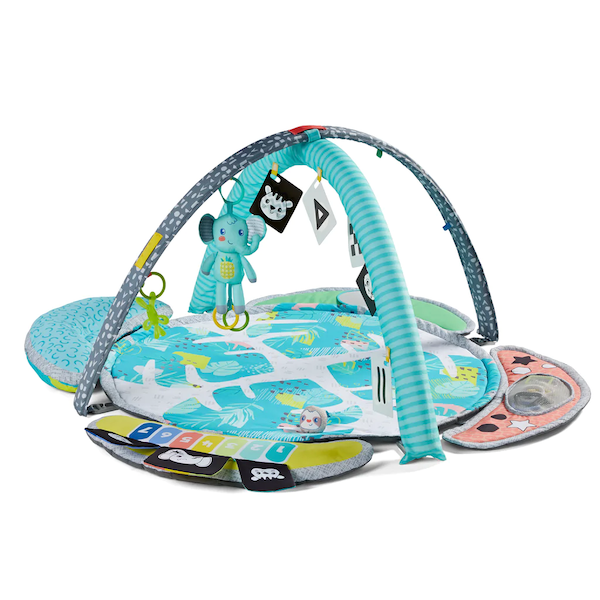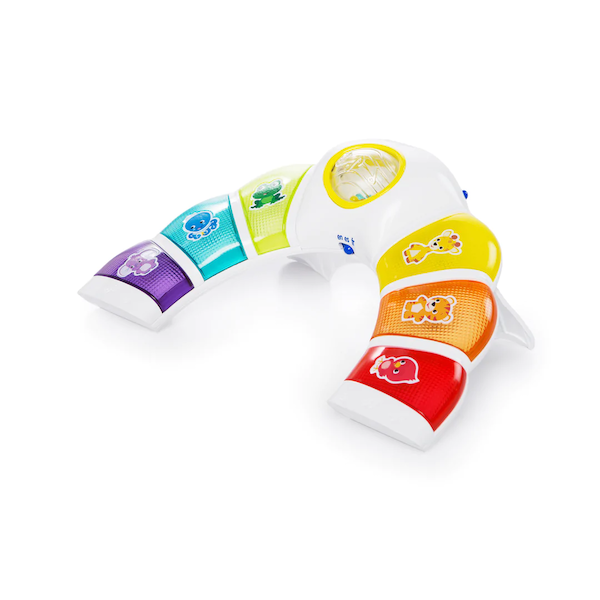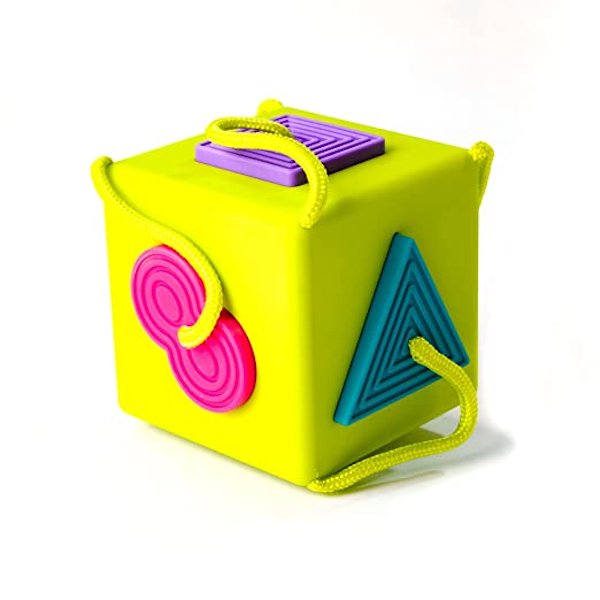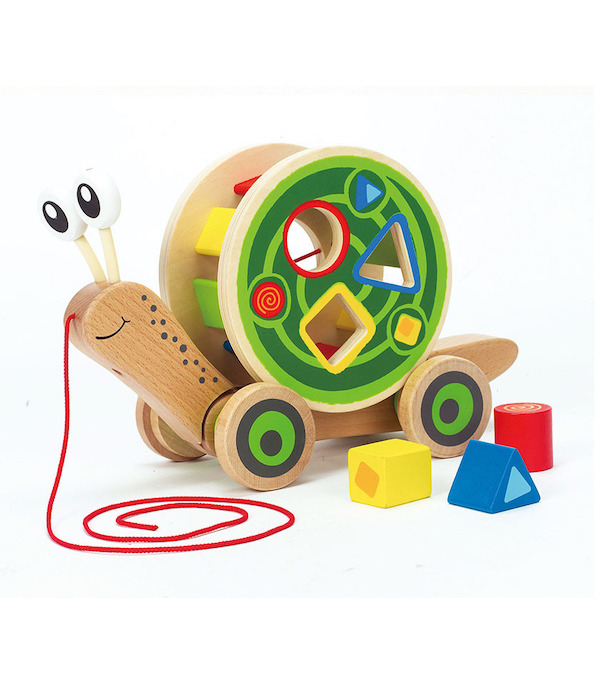12 Baby Toys that Encourage Development
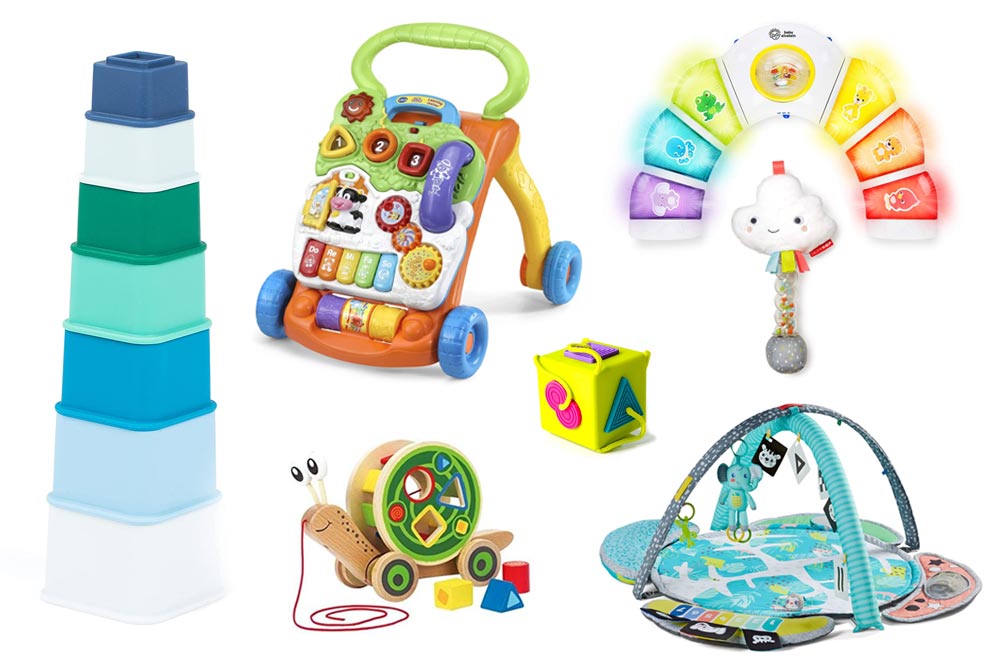
Sneak a little interactive learning into playtime with a dozen toys that not only entertain your 0-to- 12-month-old but boost their fine motor skills and brain power.
By Rebecca Rakowitz
Even the simplest of baby toys have a long-lasting impact on your little one’s motor skills, muscles, memory, and more. When stocking their toy bin, go for high-contrast, colorful contraptions that incorporate sounds, shapes, animals, and both eye and body movement.
Play Mat
Epic is an understatement! This activity gym has all the toys, play options, and sensory play experiences to spark curiosity. Overhead toys keep the littlest of babes entertained, while activity stations keep older babies engaged. Each leaf of the mat detaches for an optimal experience. One can prop baby up during tummy time, while music, animal, and shape stations can be played on the mat or on the go. Age: 0M+
Rattle
Time to shake, shake, shake! This adorable Skip Hop rattle is the perfect musical toy for little hands. Rattles engage babies’ eyes, ears, and basic fine motor skills while also teaching tots that shaking causes noise. The colorful beads make a soothing, rain-like sound, and the handle base makes a little squeak when squished. It can easily be tossed into the diaper bag when out and about, and how could you not just love a sweet smiling cloud? Age: 0M+
Stacking Cups
They may seem simple, but these stacking cups have a big impact on little learners. Picking up and placing items helps them learn intentional grasp and release, as well as how to control their fingers. We especially love these non-toxic, BPA- and PVC-free, food-grade silicone ones from Bella Tunno since babies also learn by putting nearly everything in their mouths. Age: 0M+
Mirror Toy
OK, we don’t only love the Whoozit because of its mirror, but it is a great perk! Flip the happy creature’s red nose so your baby can see the mirror and their reflection for a fun game of peek-a-boo. Among other things, mirrors help babies practice visual tracking as they scope out that familiar face. Each of Whoozit’s seven arms has a noisemaker, and can later be stuffed into internal pockets for the sake of playroom tidiness. Age: 0M+
Try it: Manhattan Toy Whoozit
Tummy Time Toy
If they are fussy on their tummy, this Baby Einstein light-up bar can hold their attention (and their head up) for a while longer. Being on their belly helps to strengthen muscles and prepare babies to eventually roll over. Plus, when you switch between animals, colors, music, and three languages (more on why that is great later!), their mind benefits, too. When they outgrow tummy time, or when they’ve had enough, collapse the toy on the floor to keep the fun going. Age: 3M+
Try it: Baby Einstein Glow & Discover Light Bar Activity Station
Suction Toy
This toy is designed for suction, but it certainly doesn’t suck (bad dad joke, we know). Attaching the appropriately named Fascination Station to your kiddo’s high chair, stroller tray, or play space encourages them to reach and bat. This strengthens hand-eye coordination while simultaneously keeping them entertained. Thousands of Amazon reviewers gave this spinner five stars. Age: 6M+
Try it: Sassy Fishy Fascination Station
Animal Toy
Sandra Boynton isn’t the only one who can teach kids their animal sounds. Melissa & Doug are getting good at it, too. When your babe presses one of the friendly animals’ noses, they’ll hear an oink, quack, moo, or baa (unfortunately there isn’t a la la la). Handles, crinkly flower petals, a mirror, bright colors, and more make this cube extra fun. Age: 6M+
Bilingual Learning
Even at just 6 months old, a baby can start to detect different languages. Bilingual toys such as this singing, crawling turtle encourages language development in both English and Spanish. This is a valuable and inclusive skill, and bilingualism has additional cognitive benefits, including improving a child’s ability to focus. Age: 6M+
Ball Game
Kids will practice fine motor skills and visual tracking as they push the button to watch colorful balls wind around the track, through the tubes, and then pop up and out. When the ball is hidden and reappears, it reinforces the cognitive concept of object permanence, which they have likely started to pick up on. Just because you don’t see an object, that doesn’t mean it no longer exists. Age: 9M+
Walker
Your tot can work on fine and gross motor skills with this walker that accommodates babies on their bottoms and babies on the go. Piano keys inspire creativity while spinning rollers and buttons enhance fine motor skills. Plus, a toy phone is just calling for imaginative play, which will become increasingly important for their social-emotional development. Age: 9M+
Shape Sorter
Your big kid can practice sorting with this sensory-focused cube. Textured and squishy shapes are great for tactile learning and even act as good teethers if your child goes for a chomp. While putting each shape in place, kids also have a chance to work on their fine motor and visual-spatial skills. And thanks to the connected strings, you never have to worry about losing a piece. #parentingwin Age: 10M+
Pull Toy
Pull or push toys are known to help babies balance and strengthen their muscles. This pull-along snail works overtime with its removable, pushable shell that comes with blocks and shape holes, so your wee one can test their noggin too. Plus, we love having a beautiful wooden toy amidst the plastic madness. Age: 12M+
Try it: Hape Pull-Along Activity Snail
It might sound like a toy industry gimmick, but playtime really does set your kiddo up for early learning and developmental success in the first year—and beyond.


